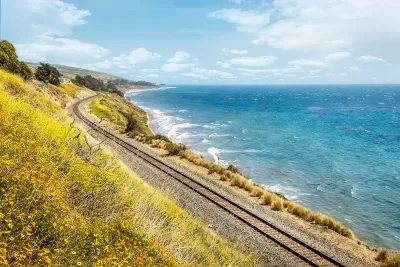Extreme weather and erosion threaten transit infrastructure around the country.

While transit agencies struggle to address the much-feared ‘fiscal cliff,’ physical cliffs pose another danger, writes Corrigan Salerno on Transportation for America.
As Salerno explains, “As climate change unfolds, transit will need the support to serve as communities’ resilient backbone through subtle, day-to-day challenges and demanding disasters.” In Southern California, one of the country’s top three busiest passenger rail corridors was disrupted for months due to coastal erosion that threatened the tracks. Now, the San Diego Association of Governments (SANDAG) is preparing a study for a new alignment that will relocate the tracks farther inland.
Salerno also points to the need for quick allocation and disbursal of emergency funds to repair weather-damaged infrastructure and restore service when disasters strike, similar to the FHWA’s Emergency Relief Program, which provides such funds for infrastructure repairs. “Just as repairs are needed for highways to continue functioning after a disaster, they’re needed to keep transit and passenger rail running on time so that people can get where they need to go.”
According to the article, “With the IIJA lapsing in 2026 and natural disasters on the rise with climate change, Congress needs to devise new policies to improve how the country restores public transit in the wake of earthquakes, hurricanes, wildfires, and even the less dramatic, predictable emergencies.”
FULL STORY: Transit’s physical cliff: Climate change

Maui's Vacation Rental Debate Turns Ugly
Verbal attacks, misinformation campaigns and fistfights plague a high-stakes debate to convert thousands of vacation rentals into long-term housing.

Planetizen Federal Action Tracker
A weekly monitor of how Trump’s orders and actions are impacting planners and planning in America.

Chicago’s Ghost Rails
Just beneath the surface of the modern city lie the remnants of its expansive early 20th-century streetcar system.

Bend, Oregon Zoning Reforms Prioritize Small-Scale Housing
The city altered its zoning code to allow multi-family housing and eliminated parking mandates citywide.

Amtrak Cutting Jobs, Funding to High-Speed Rail
The agency plans to cut 10 percent of its workforce and has confirmed it will not fund new high-speed rail projects.

LA Denies Basic Services to Unhoused Residents
The city has repeatedly failed to respond to requests for trash pickup at encampment sites, and eliminated a program that provided mobile showers and toilets.
Urban Design for Planners 1: Software Tools
This six-course series explores essential urban design concepts using open source software and equips planners with the tools they need to participate fully in the urban design process.
Planning for Universal Design
Learn the tools for implementing Universal Design in planning regulations.
planning NEXT
Appalachian Highlands Housing Partners
Mpact (founded as Rail~Volution)
City of Camden Redevelopment Agency
City of Astoria
City of Portland
City of Laramie





























